
BY JUDY CARMACK BROSS
If the pandemic has proved one thing: dogs (and cats) are our best friends. The silver lining in the tragedy has been that shelters have been emptied of animals needing forever homes and continue to be. Fostering pets is on the rise. Whether celebrating an old friendship or finding a new BFF, it’s been wonderful for us—but what about from our pet’s perspective?
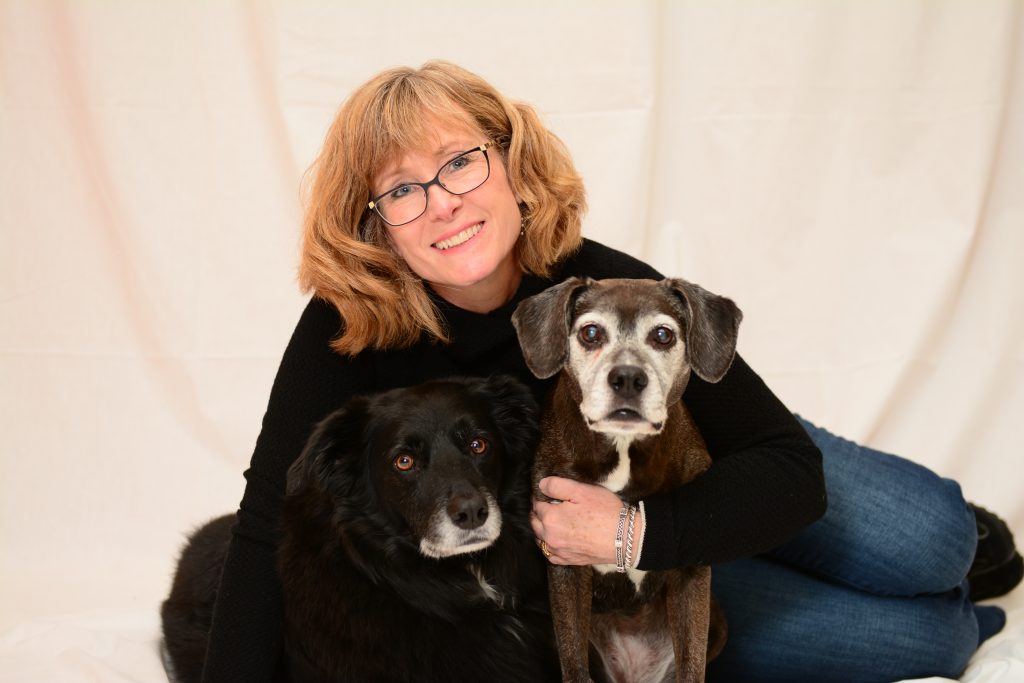
Doctor Jane Lohmar with her two dogs Lily and Penny.
We turned to our insightful veterinarian, Dr. Jane Lohmar of Family Pet Animal Hospital to ask about pets, their parents, and the pandemic: “The gifts of pets during the pandemic to our physical and emotional well being have been priceless,” she says. “First, they take us out of our own heads. We can’t slack off when there is a dog to brush, walk, clean, and feed. They are reasons for us to do things with a regular structure each day. When we may be missing other tactile sensations, they welcome our hugs and pats. Animals provide us with a sense of purpose, companionship, and acceptance when we are down.”
Even the New Yorker, known for it’s well-timed political covers, put a large magenta dog at the center of this week’s cover. It stares out the window with its owners seated in the background.
How are pets are faring during the pandemic? Dr. Lohmar shares, “The number one thing we vets are seeing is that pets are gaining weight. Cats, too, but more so dogs who have developed that way with the prick of an ear and a way of a tail that says of course you are going to give me part of your grilled cheese sandwich. People during the pandemic have been described as becoming ‘hunks, drunks, or chunks.’ With dogs it is chunks.”
She explains that over these months, owners have been taking their dogs on strolls rather than the power walks or runs they might have done in order to save time pre-pandemic, leading to dogs not burning the same calories they once did.
Duke, Gloria Groom and Joe Bertons’s dog, is an exception. He begins his day with a long jog and gets outside several other times during the day for more motion. “Our dog Duke’s biggest adjustment to the pandemic is having us both home, and he’s gotten used to having more attention,” Groom explains. “Duke has a ‘rigorous’ schedule. He gets an early morning walk with Joe. Then a 3-to-5-mile jog with me before I start work (this when the sidewalks are cleared of ice and, worse, salt!), then a mile walk around 5 when Joe and I walk to get a cup of coffee, and finally yet one more walk in the late evening to complete his day. If it’s too cold or rainy, he tries to avoid being leashed and looks at us as if to say ‘not another walk please!’ ”

Duke at rest.
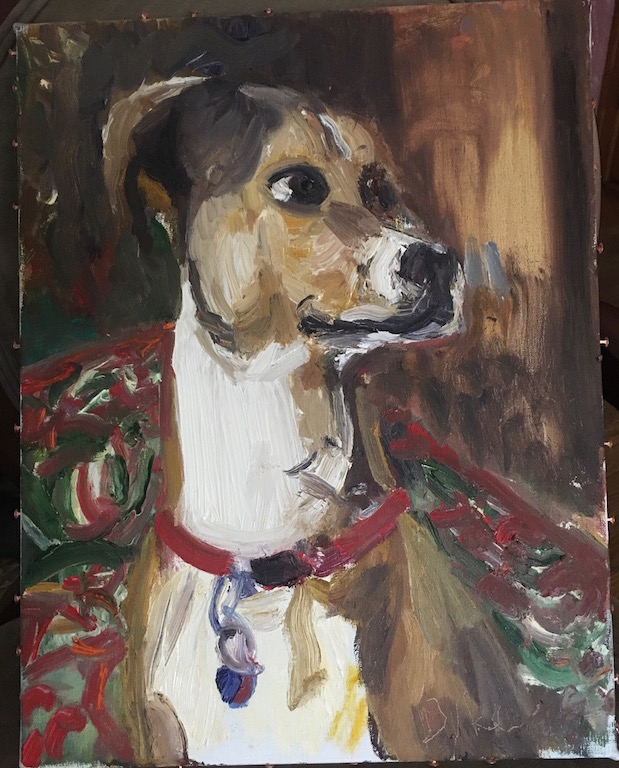
“Duke was happy to model for his portrait by SAIC instructor and artist Mark Krisco,” says Groom.
Groom shares that Duke has come to recognize the sound of the forced-air heater coming on and runs to lay on his doggie pillow conveniently located by the vent. But most of all, this winter he prefers his time with his pet parents: “He loves to hang with us, especially wedged tightly between us while we watch our nightly hour of Netflix. He particularly enjoyed ‘Call My Agent’ in French.”
Dog-owner Francie Blair reports: “Roger loves the quarantine because he is never alone. He loves the routine of having snacks at lunchtime. Sometimes he wants a shorter walk—that is his only complaint!”
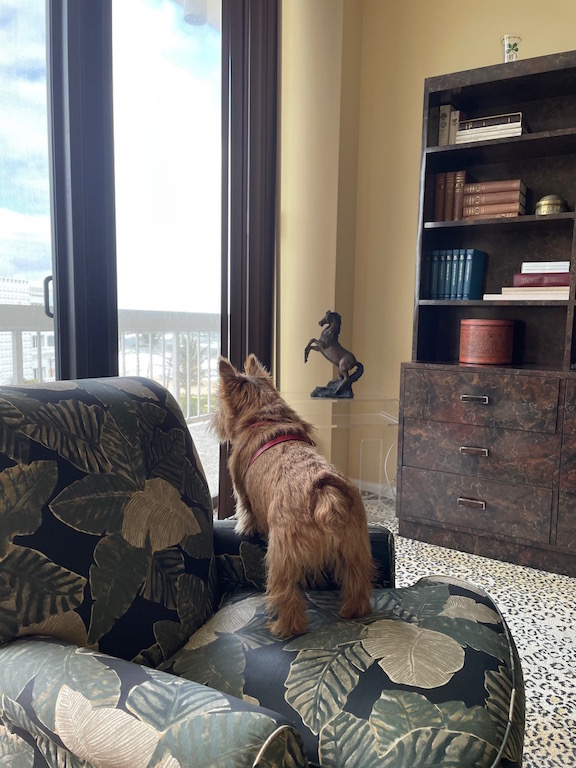
Roger Blair.
Just as we have depended on Zoom for business and social connections, dogs and cats have found what’s in it for them. Former Chicagoan George York, now in Washington D.C., reports that his dachshund, Pete, whom they brought home in January 2020, knows to station himself below his owner’s chair during an important Zoom call awaiting treats (or threatening disaster if said treats don’t arrive).
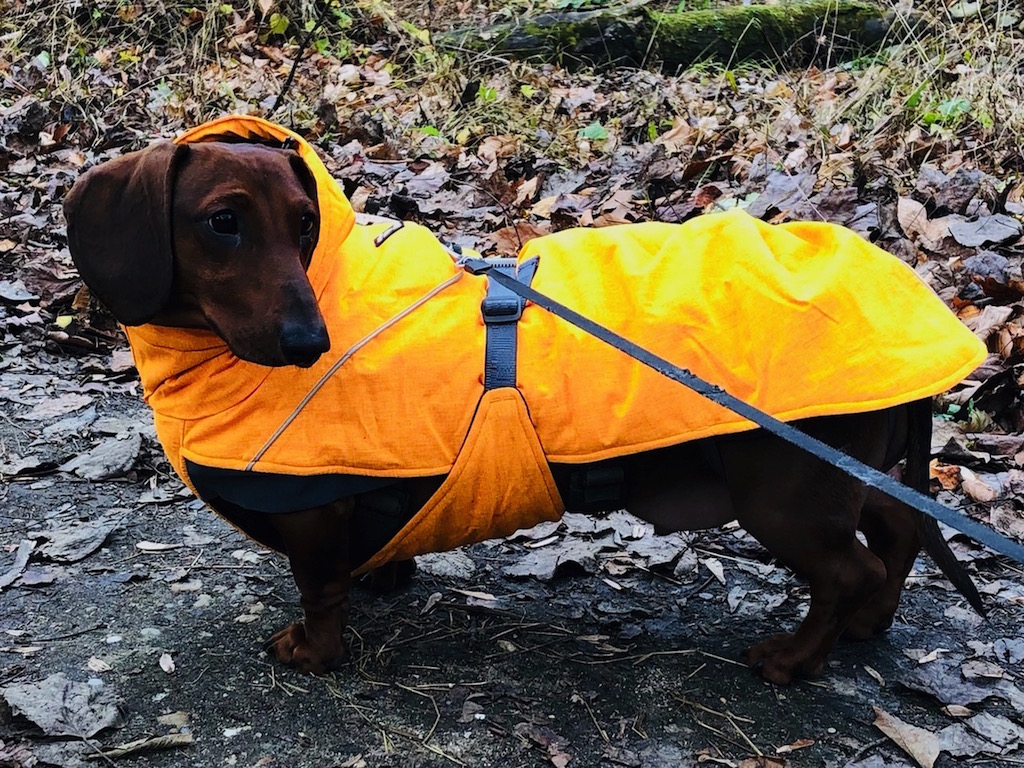
Pete sets off on a long walk with mom Julia York.
“In the midst of one important presentation scheduled for an hour, the leader’s dog began to howl, and you could hear the treats hitting the floor,” York recalls. “With Pete, if it’s a long Zoom, he is exhausted afterwards and hides to avoid a long walk. We are thinking since he doesn’t get to see his dog friends as much, that we might try a day camp at his vet’s. Right now, he now can somehow hear a UPS truck or the postman when they enter our street, and he is desperate to protect us, or to chase our cat Snowy.”
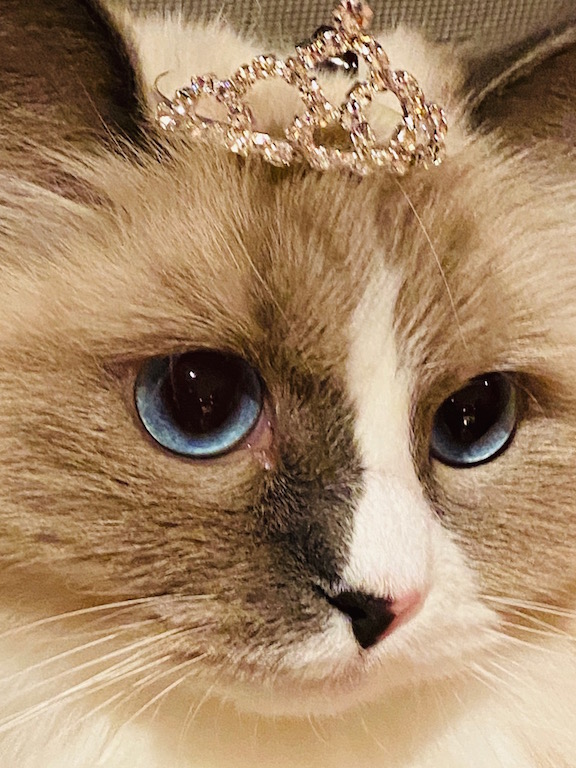
Snowy York wears a tiara for her first birthday, celebrated during the pandemic.
Duke is also a big fan of Zoom: “He especially likes to photo-bomb my many Zoom conference calls with my Art Institute co-workers who are definitely getting to know his face,” Groom says.
In a recent CNN interview, former Florida Congresswoman and a former president of the University of Wisconsin Donna Shalala happily fed her newly adopted pooch, Fauci, treats when he barked for them during an interview. This kind and humorous moment helped bring a little lightness to this dark time.
Just as we are missing in-person interaction, Dr. Lohmar reveals that our pets are feeling the same pangs: “Many dogs may still be meeting other dogs at parks or on walks, but with owners needing to maintain at least 6-feet of distance, there is definitely less socialization happening with other dogs. They might not be experiencing the away-time of doggie daycare or a dog walker that they had when their owners were at work. They may be missing this interaction.”
Los Angeles resident Lisette Bross, formerly of Chicago, believes that socialization with well-trained dogs has been vital for her young German Shepherd, Freya, adopted just 7 months ago. “One of her first encounters as a puppy was with a larger eight-year-old pit bull. At first Freya jumped all over her, barking in enthusiasm. The other dog just ignored her and gradually by the end of the hour, Freya had calmed down and was mirroring the older dog’s behavior and simply followed her around. It was key to choose the first socialization opportunity when we brought her home,” says Bross.
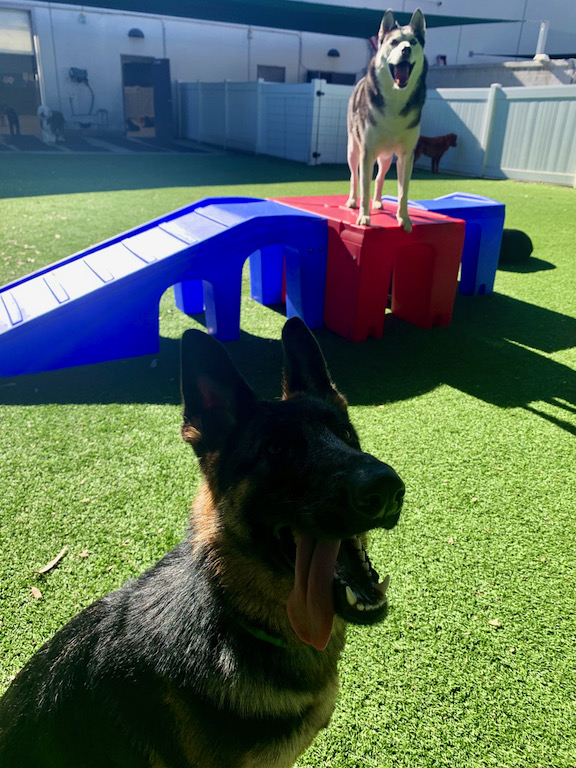
Freya (at front), a playful German Shepherd, was adopted from a Los Angeles Shelter at two months old soon after the pandemic began by her parents Lisette Bross and Ray Caccioli. Here she enjoys playtime at day camp with a pal.
Dee Bernadello, Freya’s trainer, echoes both Bross’s and Dr. Lohmar’s observations: “The pandemic has been wonderful to bring us closer to our pets, but dogs should be with dogs, as well as people. They play differently with other dogs, share their own language, and learn to socialize. In a relationship with a human, the human is always the leader. With dogs, they are all equal, and the pack mentality contributes a lot to their life. They are getting just half of the relationships that they want by just being with people. Dogs teach other dogs.”

Freya, the German Shepherd, plays with pals
Bernadello explains that when dogs aren’t walked in public places, their freedom has been cut off, even in terms of seeing other humans. She suggests looking for well-monitored public spaces and finding a bench to sit for some people- and dog-watching together, ideally after some good exercise.
In contrast, Dr. Lohmar says, “Cats may be wanting a little more of their own space.” My own cats, Sedgwick and Eugenie, relish in their time alone relaxing in various favorite spots around the house. The main exception: mealtime! (Particularly when there is chicken to be shared from our own dinners.)
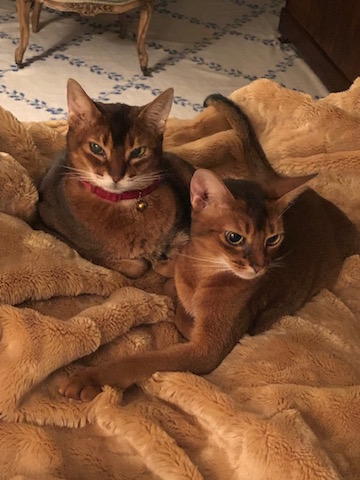
Sedgwick and Eugenie.
Classic Chicago correspondent Laurie Toth’s Himalayan cat, Alexei Nicolai (named after the Tsarevich of Russia who tragically had hemophilia and was murdered in 1918 by the Bolsheviks) has been enjoying some quite time watching the outside world: “His favorite thing is snow,” Toth says. “He loves watching it snow and actually sits at the window and purrs watching it. He is 14 years old and holds my heart in his paws!”

Alexei takes in the view.
Another fan of this winter’s snowfall is Connie Frydenlund and John Covell’s dog, Allie, who had her first experience on the farm last week, gamboling around in the yard in the fresh snow. But one of her favorite activities is enjoying entertainment with her parents, not unlike Duke: “John and I have so often said, What would we have done without her? We got her in February, and she has been our salvation. The only negative is that we have watched so much Netflix and Acorn, that we now have a dog who watches TV. Brittie, Allie’s predecessor, never watched, but Allie loves to bark at all the dogs and horses! All Creatures Great and Small drive her wild.”
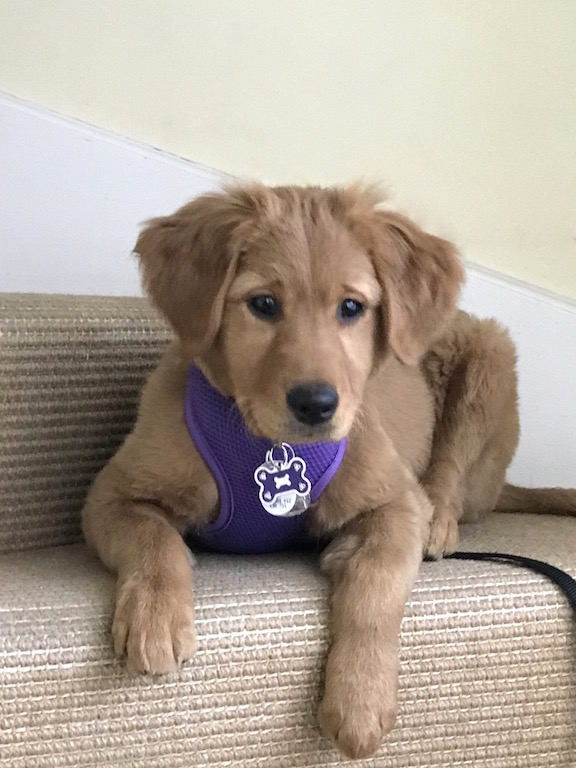
Allie as a puppy.

Allie is growing up during the pandemic.
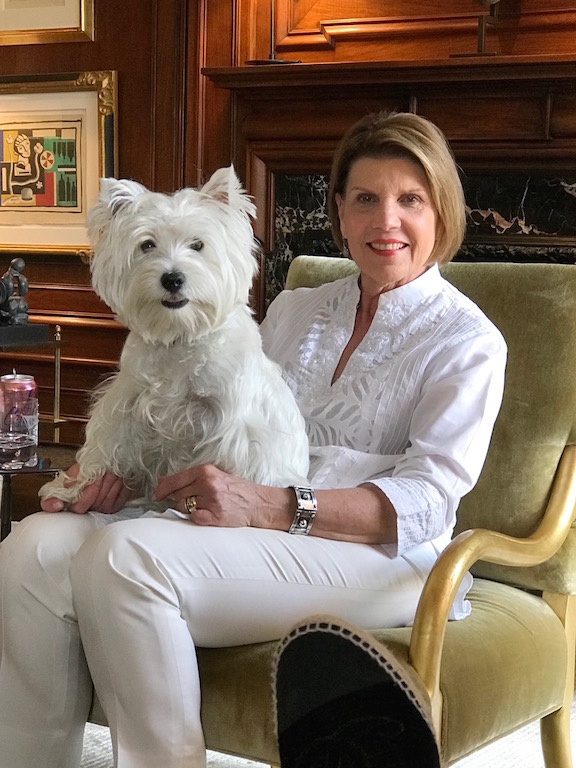
Joanne Schell and Charlie.
Joanne and Frank Schell report that they have really bonded with their young West Highland White Terrier, Charlie, during the pandemic. Alice York, who lives here in Chicago, agrees. She has a senior dachshund, adopted over five years ago, named Archie. “I teach yoga and meditation classes over Zoom and he watches or sleeps on the couch behind me,” she says. “He has become a favorite among my students!”
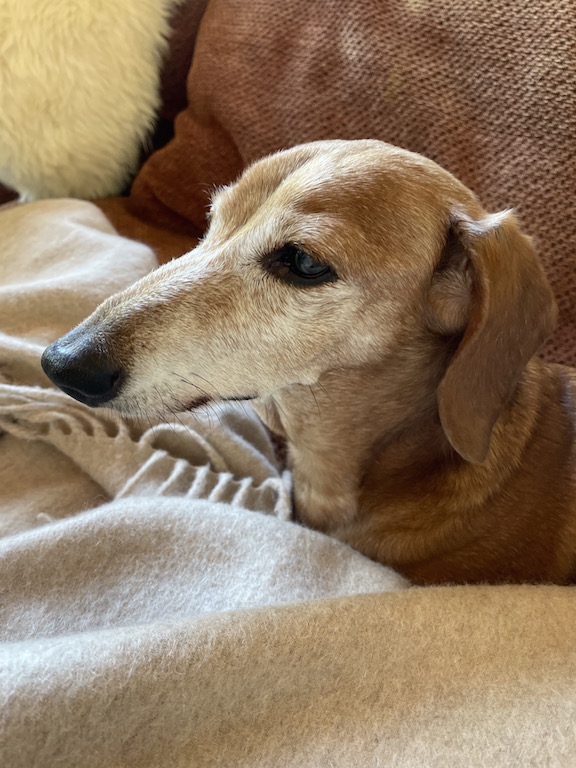
Archie on his favorite spot while his mom teaches yoga online.
While many of us have settled into a calmer, quieter rhythm with our pets, as they join us on our virtual meetings or for our favorite television shows, Dr. Lohmar has observed that people are getting somewhat more anxious about their pets. But, she says, that’s a good thing. “Owners are asking questions about things they might not have noticed before: Why is my cat drinking more water? These are not necessarily causes for concern—it is that the owners are observing their pets more.” Business is up for vets about 37 percent across the country.
“This is such a stressful time for all of us after almost a year of sheltering in place,” says Lisette Bross. “My cat, Artemis, senses this. Where before she would sometimes sleep in my bed, now she waits patiently until I go to bed and is glued to me each night.”
What to do when it comes time to go back to work? Dr. Lohmar advises, “If you have a pet who shows any signs of anxiety separation, there are plenty of books and trainers who deal with this. My advice is to start now and go out for short periods of time. That will put you on the road to success.”
If there are silver linings during the pandemic, so many are because of pet adoptions. Whether people who may have recently lost an elderly dog or cat and are ready to open their homes and hearts again or those who have never had the time or inclination or ability to take care of an animal, pet adoptions have been increasing over the past months. Dr. Lohmar shares, “I have one client who had lost an elderly dog and recently adopted. She says that she has never been so thrilled in a long time.”
If you are interested in adopting, Chicago is home to many great organizations, such as PAWS Chicago, One Tail at a Time, and the Anti-Cruelty Society. Not ready to adopt? Donations to these organizations remain crucial to the rescue process. Dr. Lohmar can be found at Family Pet Animal Hospital in Lincoln Park.






